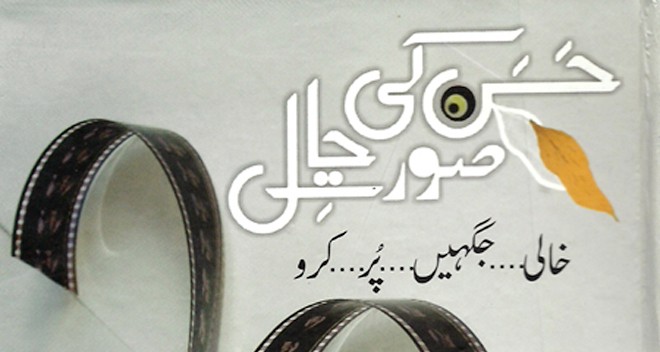
Mirza Athar Baig’s latest novel spills over the boundaries of human existence into a narrative of emptiness, awe and wonder

Hassan ki Soorat-e-haal, khali jaghain pur karo, Mirza Athar Baig’s new novel, begins with the puzzling perceptions of Hassan, drifts into the conceptions of wonderment, resolves in the narration of further perceptions, and leaves some still unresolved questions. Many streams of thoughts run parallel in the novel denying the linear singularity of truth, reality and human existence.
Reading this novel can be a creative excursion as the novel provides incisive avenues for a reader to take birth as an author and celebrates the multiplicity of meaning of the text. No static words, no fixed meanings. This is a novel of one single moment and the moment is definitively in a constant flux. This flux fills the emptiness of frozen moments (khali jaghain pur karo) with more emptiness, existential enigma, wit of paradoxes and imaginative curiosity.
Inter-subjectivity within and between moments and events, states of being and not-being, alienation and belongingness, self-doubt and conviction, deceit and deception, servitude and salvation, desire and denial, and text and context are seamless threads which weave the narrative of Hassan ki soorat-e-haal. The novel inventively ties and unties moments with moments.
Is this a novel or antinovel?
The treatment of the narrative is quite intriguing: this is a novel on a film which ends up in a theatre. One piece of fiction, which engages with three distinct genres of art wherein the individuality of and inter-subjectivity between these three remain elusive and cohesive at the same time. You can read, enact and shoot this novel.
Hassan ki soorta-e-hal is located in the Pakistan of 1980s; however, it lives in the present, reflects back and looks forward with a great sense of temporal convergence reflected in the storyline.
The style and storyline subverts an archaic formula-based causation in fiction, and breaks away with the cathartic mechanics of cause and effect. It challenges the reader by continuously connecting, disconnecting and reconnecting with the story. Mirza distinguishes between kahania and hairania: kahania is the celebration of the demise of wonderment while hairania is the celebration of eternity of wonderment. Hairania often loses its communicative genius because of the vigour of wonderment. Wonder neither begins nor ends. Hence the story of Hassan is a story of ceaseless wondering. It never ends.
Swang Productions, an evolving enterprise, is working on a script to produce a film obsessed by surrealist ideas of a self-styled director (Saeed Kamal) who comes from a bourgeois but Marxist family. He repeatedly refers to his classroom lessons on surrealism but fails to capture the surrealist surroundings. The dynamics of comradery of the production team comprising the script writer, director, cameraman, financer, and chosen characters construct and deconstruct the story of film titled Yih Film Nahin Ban sakti (this film cannot be produced).
Kabaarh Complex (junkyard) presents a potent imagery of societal malaise by indicating the tyranny of objectification of self-identity and subjectivity. The Kabaarh Complex is organised as a museum of castoffs, condemned goods and leftovers collected and catalogued in line with the guidelines of Guinness Book of Records. Irshad Kabaria and Jabbar Jama’kar are anxiously collecting and maintaining unique elements to break the numerical threshold. Apart from other interesting things they are maintaining and updating the inventory of pygmies to show that their ‘museum’ has the highest number of pygmies in the world. "Hope" is a dog fed on the rarest sweets distributed on the departure of former and arrival of new "great saviour".
The novel breathes effortlessly in a political and philosophical environment without shouting politics and philosophy. Attributions are predominantly metaphorical and simplified with flavours of ordinariness. ‘Collage of montage’ is another chapter of the novel which suggests looking at the reality as a gestalt or abstraction instead of an atomised substance.
The novel rediscovers the history of things to explain the locality of being. A roundtable placed in the office of Swang Productions opens a vista of contextual variations, and explains dark and bright sides of the itinerary of the roundtable. How it reached there, which events are related to this roundtable, and how does this signify the relationship between its usage and its users. These questions lead to knowing much more about the experiences of human existence by tracking the identity of a wooden table. The reader enters into a relationship with the roundtable as he/she gets to know more about the stories of violence, torture, death, love and creativity revolving around it.
The novel introduces an editor who intervenes to interpret some situations, and appears here and there with typical pedantic editorial notes. With the insertions of editor, the language and expression suddenly change and the reader shelves the story and tunes into another stream of thought. Chronology of events is not linear as time runs in spirals in the novel. Names of the characters remain the same but the substance of characters changes as stories unfold. Several situations emerge, evolve, intermarry, divorce, remarry and reemerge.
Some believe that Mirza Athar Baig seems to have introduced new principles of movement in Urdu fiction through his latest novel. Keeping its locale specific, the novel spills over the boundaries of human existence and becomes a narrative of a timeless moment blended with awe and wonder. Emptiness is filled by emptiness and awe is replaced by awe, thus, the story of Hassan never ends.